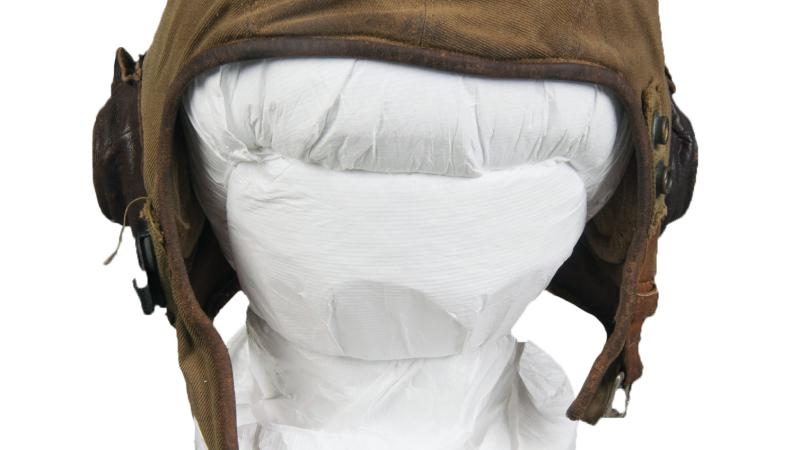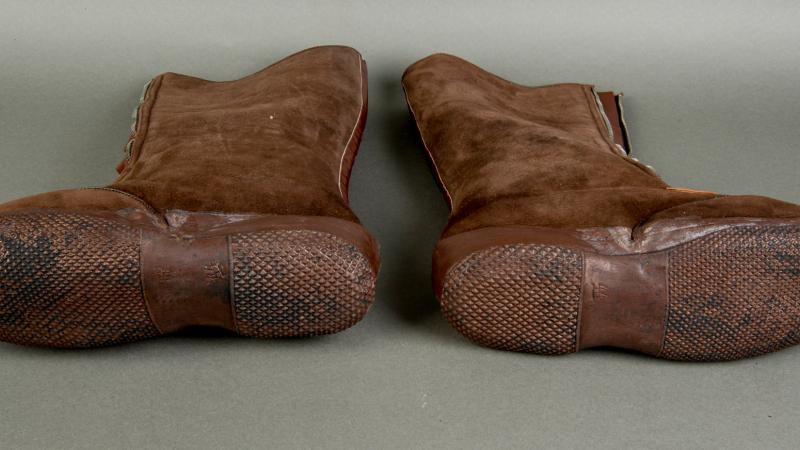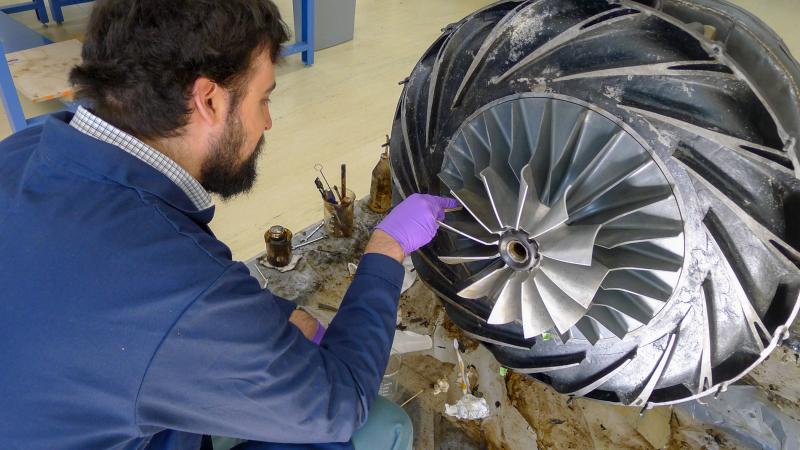At the Smithsonian Institution’s Steven F. Udvar-Hazy Center, Daniel Ravizza, '07 and '14, stands in a hangar full of objects that shaped aviation history. The center is the annex of the National Air and Space Museum.
Lindy’s Boots and Cosmonaut Chicken
Published 02.26.2020
by Tom Speicher, writer/video producer. Photos courtesy of Steven F. Udvar-Hazy Center.
The range of screw sizes is a typical early-semester topic for Keith H. English. The Pennsylvania College of Technology instructor describes the numbering system to his new machining students before revealing they will have access to the rare No. 12 thread that is usually omitted from screw-size charts.
It’s standard stuff for the instructor, who has taught automated manufacturing and machining for more than a quarter century. But the response from one student during one of those discussions was anything but standard.
This student raised his hand to supplement the lecture. While he agreed with English that the No. 12 thread is unique, he explained that a very uncommon No. 14 thread also exists. The student proved his point at the next class. He brought a No. 14 tap from his private collection.
English laughed at the memory.
A 20-year-old who has a vintage tap and die collection,” he said. “I thought, ‘This kid is special!’”
The teacher was right.
Today, that “kid” is an objects conservator at the Smithsonian Institution’s Steven F. Udvar-Hazy Center in Chantilly, Virginia, the annex of the National Air and Space Museum in Washington, D.C. Daniel J. Ravizza has combined the technical skills honed at Penn College and within industry with his lifelong love for history to preserve prized artifacts for future generations.
“I’ve always liked old stuff more than new stuff. I get to take care of old things and work with them all day, so I’m definitely happy,” said Ravizza, who resembles a bookish superhero rather than a federal contractor, thanks to his 6-foot-5 frame squeezed into a dark blue lab coat.
His appearance is appropriate for his domain. The center consists of two massive hangars full of items – from planes to satellites to the Space Shuttle Discovery – that serve as a tangible timeline of aviation and space flight. Ravizza spends most of his days in the conservation lab, where he is surrounded by numerous tables and computer workstations. Portable extraction trunks are nearby to suck up fumes emanating from organic solvents and adhesives, common ingredients to preserve history’s gems.
One day, Ravizza moves Neil Armstrong’s spacesuit. The next, he reshapes a chin strap from the helmet of famed aviator Charles Lindbergh. Later, he devises a hygienic way to open cans of space food, long ago discarded by cosmonauts.
“We want to preserve the artifact in the condition it was last used effectively, rather than bring it back to how it might have looked when new,” Ravizza said. “The preservation tasks I perform stabilize the object, so it does not get worse.”
Today’s “object” is a turbocharger that supplied extra air to the engine of an experimental German World War II high-altitude fighter. According to Ravizza’s research, only three such aircraft were built. He’s tasked with stemming the magnesium corrosion.
“Problem-solving is what I enjoy the most,” he said. “Something comes in, and we have to figure it out. It’s like, ‘What the heck is this?’ It’s incredibly fascinating to find out what it is and what its purpose was and deciding how we are going to fix it.”
Growing up in Honesdale, Ravizza loved to fix and build “stuff,” and he collected old locks and keys. It’s safe to assume he was the only kid in his class who amassed handmade European ones from the 16th and 17th centuries, as well as early American locks.
“That was always my kind of thing,” Ravizza said, as if describing a bland baseball card collection.
Three years of high school metal shop convinced him to study machining at a college close to home before enrolling at Penn College, where he earned associate degrees in toolmaking technology and automated manufacturing technology in 2007.
“I liked the instructors, the facilities, access to other programs, a wide spectrum of things,” Ravizza said. “I also liked how you could get an associate degree at Penn College and then go into the bachelor’s program. You could stop halfway if you wanted and return and painlessly fit back in.”
That’s what Ravizza did. He worked as a machinist and toolmaker for about four years to “master the trade” before returning to Penn College and obtaining a bachelor’s degree in manufacturing engineering technology in 2014.
He culminated his Penn College days by building a 1,000-pound forging hammer for his senior project. Powered by an air compressor, the machine includes a 350-pound anvil base and 90-pound hammerhead to form and shape metal.
“Dan is certainly one of our most memorable students,” English said. “Every task he did was completed to the best of his ability. The results were usually terrific. Dan was wise beyond his years. He had the ability to look at a situation and assess what needed done and would plan to achieve his goals.”
Ravizza followed that approach when it came to his career. He wished to combine craftsmanship with history, so he obtained a master’s degree in conservation studies from West Dean College of Arts and Conservation in Chichester, England.
“The program is unique. They teach silversmithing. They teach blacksmithing. You actually learn how to make stuff, as well as repairing and conservation,” Ravizza said. “It really helps to fix and conserve something if you understand how it was made. That was the appeal. Plus, with my interest in history, it was silly not to go to England, where everything is so much older.”
A part-time job at Plowden and Smith – a prestigious London firm specializing in art restoration services – and an internship at the Henry Ford Museum complemented his education. After graduate school, Ravizza worked for the Central Park Conservatory, preserving sculptures and monuments in New York City’s 843-acre green haven. Contacts made at that job led to his hiring at the Smithsonian in October 2017.
“When I studied in England, it was focused on materials, so I was more of a metal conservator,” Ravizza said. “Here, it’s more generalized. We’re responsible for metals, leather, rubber and wood. Just about anything you can imagine.”
Like a Maybach six-cylinder engine from a 1910 German Zeppelin. Ravizza spent much of his first year at the Smithsonian preparing the engine for preservation. It was stored at the museum for nearly 40 years after being half-buried in the backyard of a Baltimore home.
“There was a lot of corrosion under a lot of dried oil and a lot of preservative coating that the museum applied many years ago,” Ravizza said. “That was a lot of work. It was one of the hardest projects because the engine had spent so many years outside and in storage.”
The type of metal influences Ravizza’s choice of organic solvents to clean and combat corrosion. If the material is difficult to decipher, he employs an XRF Spectrometer. The ray gun-like device scans and identifies metals in artifacts.
He didn’t need the Spectrometer for his first assignment: unopened, distended cans of Soviet space food from the 1970s.
“There was a can of cheese that was leaking. There were cans of tuna and other things. It was a disgusting mess. We had to come up with a way to preserve the cans,” he said.
The solution? Ravizza manufactured a bacteriological can opener to cut out the bottom of the cans and trash the contents. He removed the cans’ labels, cleaned the metal cans and reattached the labels. The artifacts were ready to be preserved.
“That was pretty interesting,” he said.
Like many of his completed projects, the cans of space food aren’t on display, and Ravizza is fine with that.
“Many museums have less than 10% of their collection displayed for the public,” he said. “A large part of the Smithsonian’s mission is to preserve our history for the future. It’s possible in the future that someone will want to research a given object, or it might be put on display.”
His workplace doesn’t mimic the Penn College labs filled with computer-numerical-control machines and other manufacturing hardware, but Ravizza consistently draws on his history at the school.
“I am grateful for the solid practical skills and knowledge I learned there,” he said. “I feel the knowledge and skills have been vital in my career to date, whether in industry or a museum setting.”
And Ravizza expects to remain in his unique “museum setting” for years to come.
“Sometimes, I have to pinch myself a little,” he said. “These are one-of-a-kind things we get to work on.”
Even rarer than his No. 14 tap.





Share your comments
Penn College Magazine welcomes comments that are on topic and civil. Read our full disclaimer.
We love hearing from you